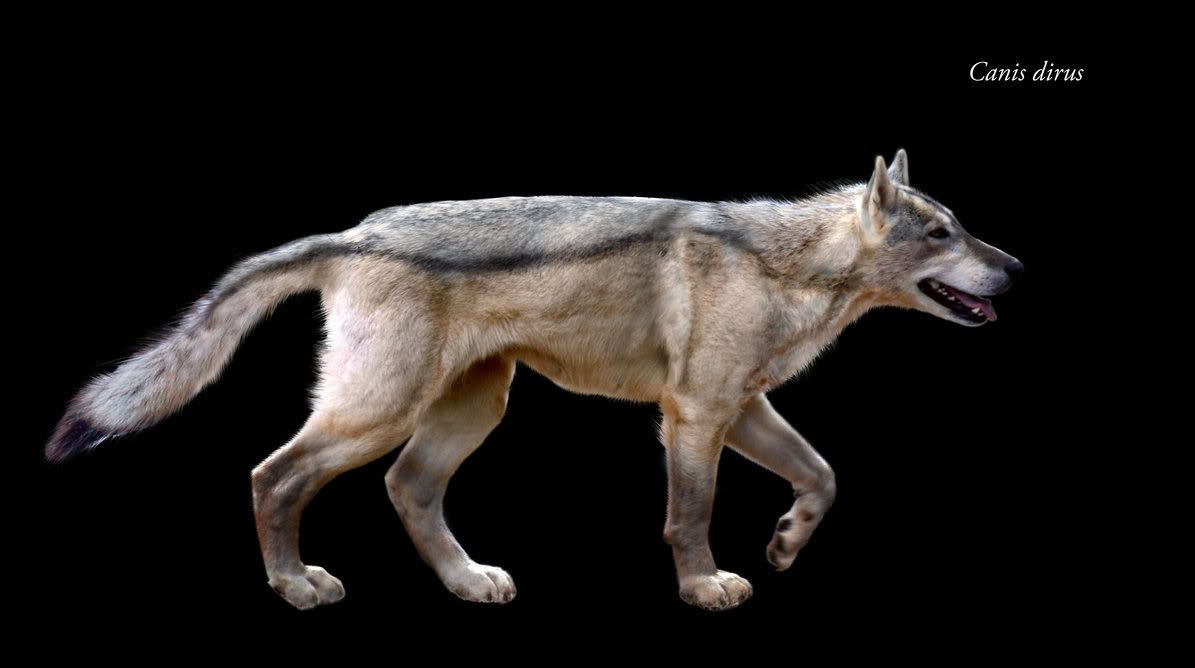Post by dinosauria101 on Apr 15, 2019 4:05:16 GMT 5
Dire Wolf (pack of 6) - Canis dirus
The Dire wolf (Canis dirus) is an extinct carnivorous mammal of the genus Canis, and was most common in North America and South America from the Irvingtonian stage to the Rancholabrean stage of the Pleistocene epoch living 1.80 Ma – 10,000 years ago, existing for approximately 1.79 million years. lthough it was closely related to the Gray Wolf and other sister species, Canis dirus was not the direct ancestor of any species known today. Unlike the Gray Wolf, which is of Eurasian origin, the Dire Wolf evolved on the North American continent, along with the Coyote. The Dire Wolf co-existed with the Gray Wolf in North America for about 100,000 years. The Dire Wolf was larger than the Gray Wolf, averaging about 1.5 metres (5 ft) in length and weighing between 50 kg (110 lb) and 79 kg (174 lb). Despite superficial similarities to the Gray Wolf, there were significant differences between the two species. The legs of the Dire Wolf were proportionally shorter and sturdier than those of the Gray Wolf, and its brain case was smaller than that of a similarly sized gray wolf. The Dire Wolf's teeth were similar to the Gray Wolf's, only slightly larger, pointing to a hypercarnivorous to mesocarnivorous activity. Paleontologist R.M. Nowak states the dietary characteristics are primarily carnivorous as well as partially omnivorous.

Giant (Long-horned) Bison - Bison latifrons
Bison latifrons is an extinct species of bison that lived in North America during the Pleistocene. Also known as the giant bison, it reached a shoulder height of 2.5 metres (8.5 feet), and had horns that spanned over 2 metres (6.5 feet). The known dimensions of the species are much larger than either extant species of bison (it was approximately twice the body size) and other extant large bovids, and B. latifrons may be the largest bovid in the fossil record. B. latifrons reached a shoulder height of 2.5 meters (8.2 ft) and weighed over 2,000 kilograms (4,400 lb).

Credit to Wikipedia
The Dire wolf (Canis dirus) is an extinct carnivorous mammal of the genus Canis, and was most common in North America and South America from the Irvingtonian stage to the Rancholabrean stage of the Pleistocene epoch living 1.80 Ma – 10,000 years ago, existing for approximately 1.79 million years. lthough it was closely related to the Gray Wolf and other sister species, Canis dirus was not the direct ancestor of any species known today. Unlike the Gray Wolf, which is of Eurasian origin, the Dire Wolf evolved on the North American continent, along with the Coyote. The Dire Wolf co-existed with the Gray Wolf in North America for about 100,000 years. The Dire Wolf was larger than the Gray Wolf, averaging about 1.5 metres (5 ft) in length and weighing between 50 kg (110 lb) and 79 kg (174 lb). Despite superficial similarities to the Gray Wolf, there were significant differences between the two species. The legs of the Dire Wolf were proportionally shorter and sturdier than those of the Gray Wolf, and its brain case was smaller than that of a similarly sized gray wolf. The Dire Wolf's teeth were similar to the Gray Wolf's, only slightly larger, pointing to a hypercarnivorous to mesocarnivorous activity. Paleontologist R.M. Nowak states the dietary characteristics are primarily carnivorous as well as partially omnivorous.

Giant (Long-horned) Bison - Bison latifrons
Bison latifrons is an extinct species of bison that lived in North America during the Pleistocene. Also known as the giant bison, it reached a shoulder height of 2.5 metres (8.5 feet), and had horns that spanned over 2 metres (6.5 feet). The known dimensions of the species are much larger than either extant species of bison (it was approximately twice the body size) and other extant large bovids, and B. latifrons may be the largest bovid in the fossil record. B. latifrons reached a shoulder height of 2.5 meters (8.2 ft) and weighed over 2,000 kilograms (4,400 lb).

Credit to Wikipedia


